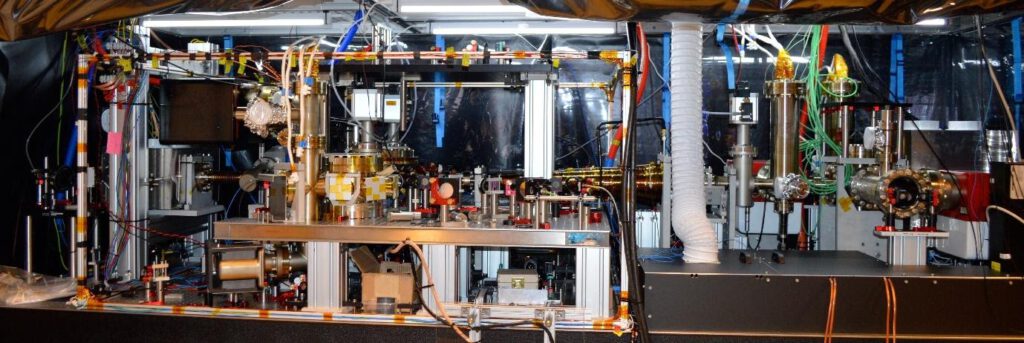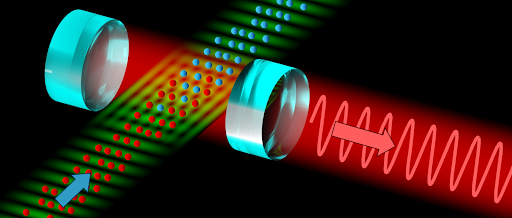
Quantum computers and simulators can solve problems that are utterly out of reach for traditional computers. At Quantum.Amsterdam we are building a quantum computer based on an array of strontium atoms held in optical tweezers inside a vacuum chamber. Quantum bits are encoded in the internal states of these atoms and quantum calculations are carried out by shining laser beams onto the atoms in a well-orchestrated way. Quantum computers based on neutral atoms profit from the fact that the atoms are naturally identical and that it is quite easy to scale the computer to hundreds of quantum bits. Our quantum computer is based on strontium atoms, an alkaline-earth element that is also commonly used to build some of the best clocks in the world.

Exploiting clock technology from our European Quantum Flagship project iqClock and strontium technology from our European Research Council project QuantStro we intend to build a quantum computer that can demonstrate algorithms developed by QuSoft and the QSC. Currently we can trap strontium atoms in an array of 16 optical tweezers and we are extending our machine with the lasers necessary to implement one- and two-qubit gates. We recently joined forces with the neutral atom quantum computing team at the TU/e and have the ambition of providing a quantum computer connected to the QuTech quantum computing cloud platform Quantum Inspire in 2024 within Quantum Delta NL.

Quantum sensors can vastly outperform their classical counterparts. The best quantum clocks would only go wrong by one second over the age of the universe and can detect the gravitational time dilation created by just one centimeter of height difference. These clocks, and atom interferometers built using similar technology, have many applications: the exploration of the underground (from the detection of old water tubes below train tracks to the observation of magma chambers filling up), the synchronization of telecom networks (enabling terrestrial navigation at the 0.1m level or GPS outage protection), the detection of gravitational wave in the infrasound regime and much more.
At Quantum.Amsterdam we are working on bringing these potential societal applications into reality by advancing quantum sensors based on ultracold strontium atoms. Within the European Quantum Flagship project iqClock we are guiding industry to build a compact and robust optical clock. Usually such clocks fill a lab room and need several PhD students for maintenance and operation. Our clock will fit into the space of two large household fridges and operate automatically in a telecom network centre. The second goal of iqClock is to demonstrate for the first time a novel and potentially simpler clock operation scheme, a continuous superradiant clock. Within the NWO Vici project SrPAL we are developing a continuous atom laser, a long-sought after, but so far unrealized device that will advance atom interferometry.

Quantum.Amsterdam has the ambition of leveraging our ultracold quantum technology expertise for economic development through an Ultracold Quantum Sensing Hub that is part of Quantum Delta NL. This hub will comprise two facilities. The first is a Dutch Quantum Clock, a reliable strontium optical lattice clock that will serve as an ultraprecise time and frequency reference for the Dutch time and frequency distribution network. The initial partners to build and operate this clock and network are VU Amsterdam, the Dutch metrology institute VSL, and SURF. The ambition is to establish high-precision time and frequency distribution as a commercial service and to help users develop applications of this service, such as synchronization of radio telescopes or telecom networks, or GPS outage proofing of applications that currently rely on GPS for synchronization.
The second facility is an industry testbed for ultracold quantum sensors. This testbed consists of a modular optical clock/atom interferometer and personnel that will support industry in many ways to develop components, systems and services based on ultracold quantum sensors. For example, we envision to work with LioniX and TU Twente to develop photonic chips for strontium clocks, which are crucial to render such clocks small enough for a large market or placement on satellites. We will work with ESTEC on compact clock vacuum chambers. And we will explore ultracold quantum sensing applications, for example atom interferometry for inertial navigation together with TNO. VU Amsterdam and OPNT will exploit the testbed to advance time and frequency distribution solutions.
The Ultracold Quantum Sensing Hub will be crucial to exploit the immense know-how of Dutch researchers and technological prowess of Dutch companies for the creation of commercial ultracold quantum sensing solutions.